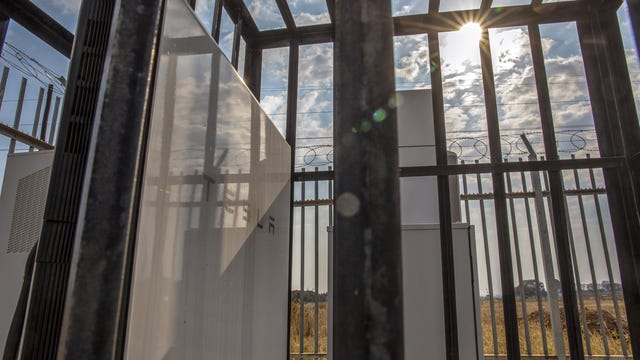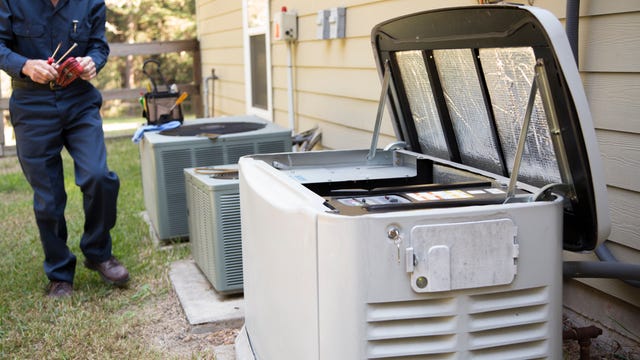Backup Power Solutions: How to Choose Between Home Batteries and Generators – CNET
Facing down severe weather and the possibility of a power outage? You’ve got options to keep the lights on.
Gone are the days when your only option was the fuel-powered standby generators. Quieter, fume-free alternatives have arrived and are here to stay: home battery backups. While generators can run as long as long as you have fuel (usually propane, natural gas or diesel) to feed them, batteries come without the carbon monoxide risk, noise or (as much of) the fuel cost. Solar panels can keep your battery topped up but come with their own price tag.
Both batteries and generators provide the same basic service but are considerably different devices. We’ll sort through the pros and cons of each. Here’s what you need to know to decide between the two.
Offering the full suite of Generac’s gas powered generators and rechargeable backup batteries, Canter Power Systems has been providing back-up power options for 70 years and is now the largest full-service generator installer in the nation.

Home battery
Home battery backup systems, like the Tesla Powerwall or the LGES 10H and 16H Prime, store energy, which you can use to power your house during an outage. Batteries get that electricity from your home solar system or the electrical grid. As a result, they’re much better for the environment than fuel-powered generators. They also might be better for your wallet.
Separately, if you have a time-of-use utility plan, you can use a battery backup system to save money on your electricity bill. Instead of paying high electricity rates during peak usage hours, you can use energy from your battery backup to power your home. In off-peak hours, you can use your electricity as normal — but at a cheaper rate — and recharge your battery when it costs less.
If you have solar panels, you’ll be able to store any excess electricity generated by your solar panels. This stored electricity can be used to power your home during the nighttime and periods of panel inefficiency.
Virtual power plants, where you give up a bit of control over your battery’s charge to your utility or another third party, are increasingly available. By giving up some access to the energy stored in your battery, you can earn a bit of money.

Generators
On the other hand, standby generators connect to your home’s electrical panel and kick on automatically when the power goes out. Generators run on fuel to keep your electricity on during an outage — typically natural gas, liquid propane or diesel. Other generators have a “dual fuel” feature, meaning that they can run on either natural gas or liquid propane.
Certain natural gas and propane generators can connect to your home’s gas line or propane tank, so there’s no need to refill them manually. Diesel generators, however, will need to be topped up in order to keep running.
Battery backup vs. generator: How do they compare?
They perform the same basic job but come with different costs, maintenance requirements and performance.
Pricing
In terms of cost, battery backups are the pricier option upfront. But generators need fuel to run, which means that you’ll spend more over time to maintain a steady fuel supply.
With battery backups, you’ll need to pay for the backup battery system upfront, as well as installation costs (each of which are in the thousands). Exact pricing will vary based on which battery model you choose and how many of them you need to power your home. However, it’s common for an average-size home battery backup system to run between $10,000 and $20,000.
For generators, the upfront costs are slightly lower. On average, the price of purchasing and installing a standby generator can range from $7,000 to $15,000. However, remember that generators require fuel to run, which will increase your operating expenses. The specific costs will depend on a few factors, including the size of your generator, which type of fuel it uses and the amount of fuel used to run it.
Installation
Battery backups earn a slight edge in this category since they can be mounted to the wall or floor, whereas generator installations require a bit of additional work. Regardless, you’ll need to hire a professional for either type of installation, both of which will require a full day of work and may cost several thousand dollars.
Some home batteries are more like oversized portable power stations, and require little more than having an electrician install a transfer switch or smart electrical panel.
Aside from setting up the device itself, installing a generator also requires pouring a concrete slab, connecting the generator to a dedicated fuel source and installing a transfer switch.
Maintenance
Battery backups are the clear winner in this category. They’re quiet, run independently, don’t produce any emissions and don’t require any ongoing maintenance.
On the other hand, generators can be quite noisy and disruptive when they’re in use. They also emit exhaust or fumes, depending on which type of fuel they use to run — which may irritate you or your neighbors.
Keeping your home powered
As far as how long they can keep your home powered, standby generators easily outperform battery backups. As long as you have enough fuel, generators can run continuously for up to three weeks at a time (if necessary).
That’s simply not the case with battery backups. Let’s use the Tesla Powerwall as an example. It has 13.5 kilowatt-hours of storage capacity, which can provide power for a few hours on its own. You can get extra power out of them if they’re part of a solar panel system or if you use multiple batteries in a single system.
Here Are 23 Ways to Save On Your Electric Bills Right Now
Expected lifespan and warranty
In most cases, battery backups come with longer warranties than standby generators. However, these warranties are measured in different ways.
Over time, battery backup systems lose the ability to hold a charge, much like phones and laptops. For that reason, battery backups include an end-of-warranty capacity rating, which measures how effective a battery will hold a charge by the end of its warranty period. In Tesla’s case, the company guarantees that the Powerwall battery should retain 70% of its capacity by the end of its 10-year warranty.
Some backup battery manufacturers also offer a “throughput” warranty. This is the number of cycles, hours or energy output (known as “throughput”) that a company guarantees on its battery.
With standby generators, it’s easier to estimate lifespan. Good-quality generators can run for 3,000 hours, as long as they’re well maintained. Therefore, if you run your generator for 150 hours per year, it should last about 20 years.
Which battery backup is right for you?
Across most categories, battery backup systems come out on top. In short, they’re better for the environment, easier to install and cheaper to run long-term. Plus, they have longer warranties than standby generators.
With that said, traditional generators can be a good option in some cases. Unlike battery backups, you only need a single generator to restore power in an outage, which brings down the upfront costs. Plus, standby generators can last longer than battery backup systems in a single session. As a result, they’ll be a safer bet if the power is out for days at a time.
Of course, you might not need that big of a solution if you’re only planning to back up a few things for short periods of time. You can also consider less-permanent solutions like portable generators and portable power stations if your needs aren’t as intensive.
How long does a solar battery last?
Many solar batteries are warrantied for 10 or even 15 years. Batteries lose some of their capacity over the course of their lifetime. Tesla Powerwalls, for example, are guaranteed to have at least 70% of their capacity at the end of their 10 year warranty.
How long can a home battery backup your home?
This depends entirely on how much you’re trying to power during an outage. A Tesla Powerwall has a capacity of 13.5 kilowatt-hours. If you want to keep the lights on and you have one 100-watt lightbulbs, you could theoretically keep it burning for 135 hours. If you want to add a refrigerator that requires 500 watts, it would reduce your run time to 22.5 hours. If you want to have a power-outage movie marathon on your 500-watt tv, your charge would last for a bit over 12 hours. When a backup battery is installed, you might be able to designate critical loads and send battery power only to those circuits during a blackout.
If your battery is connected to solar panels, it’ll recharge throughout the day, extending its useful charge, sometimes over days.

